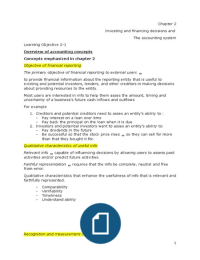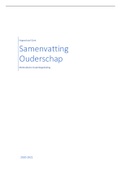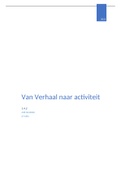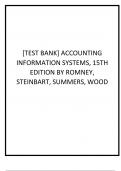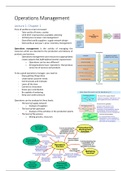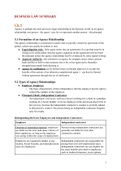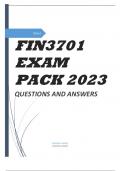Chapter 2
Investing and financing decisions and
The accounting system
Learning Objective 2-1
Overview of accounting concepts
Concepts emphasized in chapter 2
Objective of financial reporting
The primary objective of financial reporting to external users
to provide financial information about the reporting entity that is useful to
existing and potential investors, lenders, and other creditors in making decisions
about providing resources to the entity.
Most users are interested in info to help them asses the amount, timing and
uncertainty of a business’s future cash inflows and outflows
For example
1. Creditors and potential creditors need to asses an entity’s ability to :
- Pay interest on a loan over time
- Pay back the principal on the loan when it is due
2. Investors and potential investors want to asses an entity’s ability to:
- Pay dividends in the future
- Be successful so that the stock price rises so they can sell for more
than that they bought it for.
Qualitative characteristics of useful info
Relevant info capable of influencing decisions by allowing users to assess past
activities and/or predict future activities.
Faithful representation requires that the info be complete, neutral and free
from error.
Qualitative characteristics that enhance the usefulness of info that is relevant and
faithfully represented.
- Comparability
- Verifiability
- Timeliness
- Understand ability
Recognition and measurement concepts
1
, - Separate-entity assumption states that each business’s activities
must be accounted for separately from the activities of its owners, all
other persons, and other entities. (personal stuff is not property and an
asset of the entity)
- Continuity assumption (going concern assumption) we assume that
the business will continue operating into the foreseeable future, long
enough to meet its contractual commitments and plans.
- Stable monetary unit assumption each business entity accounts for
and reports its financial results primarily in terms of the national
monetary unit, without any adjustment for changes in purchasing
power.
Accountants measure the elements of the balance sheet using what is called a
mixed-attribute measurement model.
Historical cost principle or cost principle most balance sheet elements are
recorded at their cash-equivalent value on the date of the transaction.
For example: assets are initially recorded at the cash paid plus the dollar value of
all noncash considerations on the exchange date.
Elements of the balance sheet
Assets probable future economic benefits owned or controlled by an entity as
a result of past transactions or events. (the economic resources the entity
acquired to use in operating the company in the future)
Current assets are those resources that an entity use or turn into cash within
one year.
They include :
- cash
- short term investments
- accounts receivable (due from customers and others)
- supplies (to make the product)
- prepaid expenses ( rent, insurance, advertising paid in advance of use)
- inventory, only for manufacturers that produce and sell and
merchandisers who sell. (goods to be sold) after account receivable.
Inventory is always considered a current asset, regardless of how long it takes to
produce and sell the inventory.
All other assets are considered long term (or noncurrent) to be used or turned
into cash after the coming year.
- Property and equipment (land, buildings)
- Investments (in other companies)
- Intangibles (nonphysical assets such as trademarks and patents)
Liabilities probable future sacrifices of economic benefits arising from present
obligations of a business as a result of past transactions or events.
2
Investing and financing decisions and
The accounting system
Learning Objective 2-1
Overview of accounting concepts
Concepts emphasized in chapter 2
Objective of financial reporting
The primary objective of financial reporting to external users
to provide financial information about the reporting entity that is useful to
existing and potential investors, lenders, and other creditors in making decisions
about providing resources to the entity.
Most users are interested in info to help them asses the amount, timing and
uncertainty of a business’s future cash inflows and outflows
For example
1. Creditors and potential creditors need to asses an entity’s ability to :
- Pay interest on a loan over time
- Pay back the principal on the loan when it is due
2. Investors and potential investors want to asses an entity’s ability to:
- Pay dividends in the future
- Be successful so that the stock price rises so they can sell for more
than that they bought it for.
Qualitative characteristics of useful info
Relevant info capable of influencing decisions by allowing users to assess past
activities and/or predict future activities.
Faithful representation requires that the info be complete, neutral and free
from error.
Qualitative characteristics that enhance the usefulness of info that is relevant and
faithfully represented.
- Comparability
- Verifiability
- Timeliness
- Understand ability
Recognition and measurement concepts
1
, - Separate-entity assumption states that each business’s activities
must be accounted for separately from the activities of its owners, all
other persons, and other entities. (personal stuff is not property and an
asset of the entity)
- Continuity assumption (going concern assumption) we assume that
the business will continue operating into the foreseeable future, long
enough to meet its contractual commitments and plans.
- Stable monetary unit assumption each business entity accounts for
and reports its financial results primarily in terms of the national
monetary unit, without any adjustment for changes in purchasing
power.
Accountants measure the elements of the balance sheet using what is called a
mixed-attribute measurement model.
Historical cost principle or cost principle most balance sheet elements are
recorded at their cash-equivalent value on the date of the transaction.
For example: assets are initially recorded at the cash paid plus the dollar value of
all noncash considerations on the exchange date.
Elements of the balance sheet
Assets probable future economic benefits owned or controlled by an entity as
a result of past transactions or events. (the economic resources the entity
acquired to use in operating the company in the future)
Current assets are those resources that an entity use or turn into cash within
one year.
They include :
- cash
- short term investments
- accounts receivable (due from customers and others)
- supplies (to make the product)
- prepaid expenses ( rent, insurance, advertising paid in advance of use)
- inventory, only for manufacturers that produce and sell and
merchandisers who sell. (goods to be sold) after account receivable.
Inventory is always considered a current asset, regardless of how long it takes to
produce and sell the inventory.
All other assets are considered long term (or noncurrent) to be used or turned
into cash after the coming year.
- Property and equipment (land, buildings)
- Investments (in other companies)
- Intangibles (nonphysical assets such as trademarks and patents)
Liabilities probable future sacrifices of economic benefits arising from present
obligations of a business as a result of past transactions or events.
2


